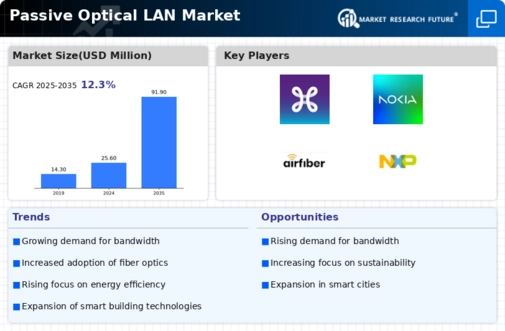Top Industry Leaders in the Passive Optical LAN Market

A Competitive Landscape of Passive Optical LAN Market:
The Passive Optical LAN (POL) market, a segment of the broader optical networking landscape, is experiencing a surge in growth driven by increasing demand for high-bandwidth, reliable, and future-proof solutions. This shift towards POL from traditional copper-based networks presents a dynamic and competitive environment for players across the value chain.
Some of the Passive Optical LAN companies listed below:
- Proximus Group
- CommScope Holding Company Inc.
- Nokia
- Airfiber
- Verizon Communications
- Mitsubishi Electric Corporation
- Huawei Technologies Co Ltd.
- Intelligent Fiber Optic Systems Corporation
- Fotech Solutions Ltd.
- NXP Semiconductors
Strategies adopted by key players:
In this competitive race, players are adopting diverse strategies to secure and expand their market share. Some key approaches include:
- Product Differentiation: Companies are constantly innovating with new features and functionalities in their POL offerings. This includes advancements in fiber optic technology, enhanced security protocols, and integration with emerging technologies like IoT and cloud computing.
- Vertical Market Focus: Players are tailoring their solutions to specific industry needs. For instance, developing POL solutions for data centers, healthcare facilities, educational institutions, and manufacturing plants with unique requirements.
- Geographical Expansion: Emerging markets like Asia-Pacific and Latin America are witnessing significant POL adoption due to rapid infrastructure development and increasing demand for bandwidth. Established players are actively expanding their presence in these regions through partnerships and acquisitions.
- Cost Optimization: POL solutions, while offering long-term benefits, can have higher upfront costs compared to traditional networks. Players are focusing on cost-effective manufacturing processes, competitive pricing strategies, and flexible financing options to make POL more accessible.
Factors for Market Share Analysis:
Evaluating market share in the POL market requires considering various factors beyond just revenue figures. Some crucial metrics include:
- Technology Adoption: The number of installations and deployments of POL solutions in different sectors.
- Customer Base: The breadth and diversity of customers, ranging from small businesses to large enterprises and government institutions.
- Geographical Presence: The geographical reach and market penetration in different regions.
- Product Portfolio: The range and depth of POL offerings, including components, systems, and management software.
- Brand Reputation: The company's reputation for quality, reliability, and innovation in the fiber optic networking space.
New and Emerging Companies:
While established players hold a significant share, the POL market is also witnessing the rise of new and emerging companies. These startups are often driven by innovative technologies, disruptive business models, and a focus on niche applications. Some examples include:
- SiFi Networks: Specializes in compact and cost-effective POL solutions for small and medium-sized businesses.
- Lumentum: Offers advanced optical networking components and test equipment for POL deployments.
- Infinera: Provides high-performance PON solutions for data centers and service providers.
These new entrants are challenging the status quo by offering agile solutions, flexible pricing models, and rapid deployment options. Their presence is likely to further diversify the market and drive innovation in the coming years.
Latest Company Updates:
September 2023- Recently, 100 schools located in Gyeonggi-do, South Korea put in a passive optical LAN system from Nokia and its partner Dongkuk Systems, as well as indirect reseller Erum I&C. The goal of installing this system is to improve the present infrastructure and give a high-capacity network that supports digital education. This effort is part of the Korean Ministry of Education's Green Smart School program, which seeks to turn current school facilities into intelligent learning environments for new and digital ways of learning, including making large-capacity multimedia classrooms. The newly upgraded network enables the schools to hold classes using Augmented Reality (AR) and Virtual Reality (VR). Furthermore, the network can be upgraded to 10G and higher without needing any extra cabling.
July 2023- Orlando International Airport has deployed Tellabs Optical LAN to gain high-speed, future-proof, and energy-efficient connectivity. Orlando International Airport is one amid the first airports to install a 10 gigabit Passive Optical LAN using innovative fiber-optic technology. This provides the airport with high bandwidth, scalability for the future, and energy savings. Tellabs Optical LAN is an ideal choice for modern airport networks, as it improves the online experience for passengers, retailers, and staff over wireless and fiber networks. It also lays the proper foundation for the airport's digital transformation. Orlando International Airport is one amid the first airports to utilize a symmetrical 10 gigabit Optical LAN that extends connectivity for miles across a passive fiber optic network. This extended reach allowed them to reduce the number of telecom closets required for IT systems. With fewer closets, the airport saves on power and HVAC costs. Even better, the airport converted the real estate footprint gained into revenue-generating space.
